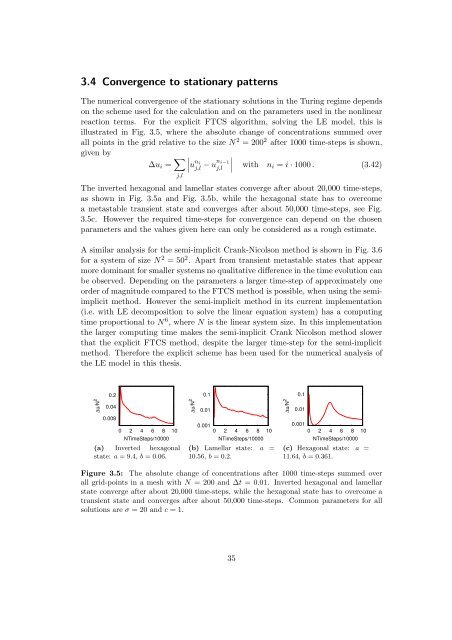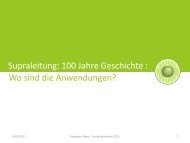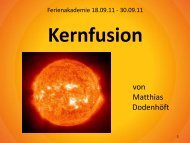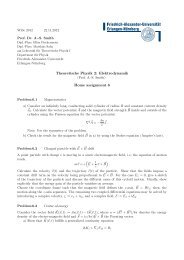Morphology of Experimental and Simulated Turing Patterns
Morphology of Experimental and Simulated Turing Patterns
Morphology of Experimental and Simulated Turing Patterns
You also want an ePaper? Increase the reach of your titles
YUMPU automatically turns print PDFs into web optimized ePapers that Google loves.
3.4 Convergence to stationary patternsThe numerical convergence <strong>of</strong> the stationary solutions in the <strong>Turing</strong> regime dependson the scheme used for the calculation <strong>and</strong> on the parameters used in the nonlinearreaction terms. For the explicit FTCS algorithm, solving the LE model, this isillustrated in Fig. 3.5, where the absolute change <strong>of</strong> concentrations summed overall points in the grid relative to the size N 2 = 200 2 after 1000 time-steps is shown,given by∆u i = ∑ ∣∣u n ij,l − un i−1j,l ∣ with n i = i · 1000. (3.42)j,lThe inverted hexagonal <strong>and</strong> lamellar states converge after about 20,000 time-steps,as shown in Fig. 3.5a <strong>and</strong> Fig. 3.5b, while the hexagonal state has to overcomea metastable transient state <strong>and</strong> converges after about 50,000 time-steps, see Fig.3.5c. However the required time-steps for convergence can depend on the chosenparameters <strong>and</strong> the values given here can only be considered as a rough estimate.A similar analysis for the semi-implicit Crank-Nicolson method is shown in Fig. 3.6for a system <strong>of</strong> size N 2 = 50 2 . Apart from transient metastable states that appearmore dominant for smaller systems no qualitative difference in the time evolution canbe observed. Depending on the parameters a larger time-step <strong>of</strong> approximately oneorder <strong>of</strong> magnitude compared to the FTCS method is possible, when using the semiimplicitmethod. However the semi-implicit method in its current implementation(i.e. with LE decomposition to solve the linear equation system) has a computingtime proportional to N 6 , where N is the linear system size. In this implementationthe larger computing time makes the semi-implicit Crank Nicolson method slowerthat the explicit FTCS method, despite the larger time-step for the semi-implicitmethod. Therefore the explicit scheme has been used for the numerical analysis <strong>of</strong>the LE model in this thesis.∆u/N 20.20.040.0080 2 4 6 8 10NTimeSteps/10000(a) Inverted hexagonalstate: a = 9.4, b = 0.06.∆u/N 20.10.010.0010 2 4 6 8 10NTimeSteps/10000(b) Lamellar state: a =10.56, b = 0.2.∆u/N 20.10.010.0010 2 4 6 8 10NTimeSteps/10000(c) Hexagonal state: a =11.64, b = 0.361.Figure 3.5: The absolute change <strong>of</strong> concentrations after 1000 time-steps summed overall grid-points in a mesh with N = 200 <strong>and</strong> ∆t = 0.01. Inverted hexagonal <strong>and</strong> lamellarstate converge after about 20,000 time-steps, while the hexagonal state has to overcome atransient state <strong>and</strong> converges after about 50,000 time-steps. Common parameters for allsolutions are σ = 20 <strong>and</strong> c = 1.35






